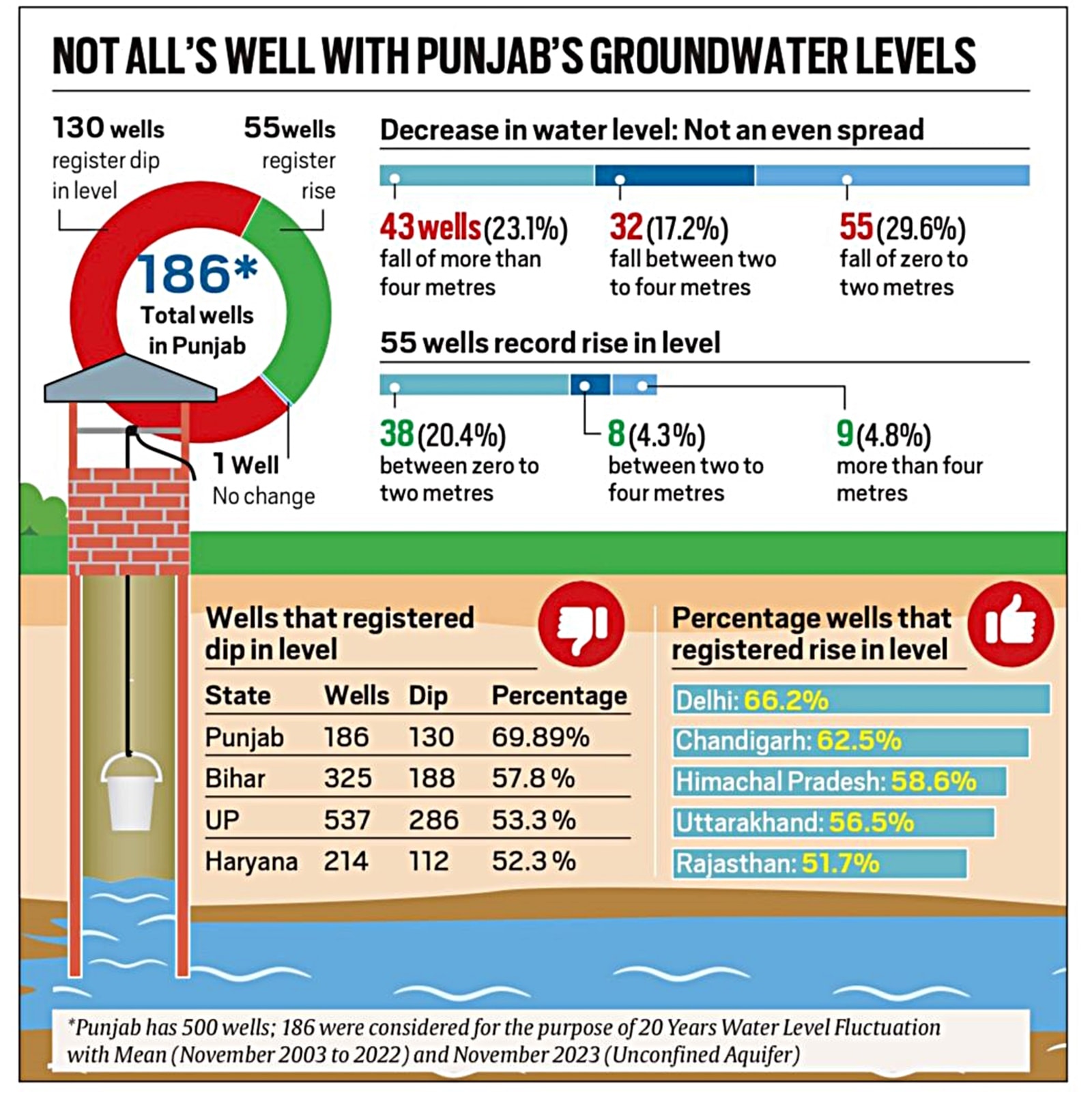Groundwater level falling fastest in Punjab, 70% wells register dip — some by 4 metres
The National Capital Delhi, Union Territories of Chandigarh and Jammu and Kashmir, and Himachal Pradesh, Uttarakhand and Rajasthan recorded an overall rise in the water levels in the corresponding period.
 The average depletion in wells of 10 north Indian states and Union Territories has been recorded at 51.5 percent with 1,201 wells out of 2,329 registering fall in water levels. (wikimedia commons)
The average depletion in wells of 10 north Indian states and Union Territories has been recorded at 51.5 percent with 1,201 wells out of 2,329 registering fall in water levels. (wikimedia commons)Nearly 70% wells in Punjab — 130 out of 186 — have registered varying degree of fall in water level, in some cases by more than four metres, by November 2023 — in comparison to the mean of water level fluctuation from November 2003 to 2022 — putting the state at the top of the list among north Indian states and Union Territories.
Of 186 wells in Punjab that were considered for the water level fluctuation, at least 43 wells (23.1%) in unconfined aquifers recorded a fall of more than four meters, 32 (17.2%) registered a fall of water level between two to four meters, and 55 (29.6%) witnessed a fall of zero to two meters. No change was observed in one well.
The information was provided by Union Minister of State for Jal Shakti Raj Bhushan Choudhary in the Parliament in response to a query by Rajya Sabha member Neeraj Shekhar who sought to know whether, as per the recent study report of IIT-Gandhinagar, huge depletion in groundwater level have been reported in North India between 2002 to 2021.
Shekhar also sought to know the details of action taken by the government to arrest the depletion in groundwater in the Northern States.
As per the reply, 55 wells (nearly 30%) registered a rise in water level in the corresponding period with 38 (20.4%) recording increase between zero to two metres, eight (4.3 %) between two to four meters, and nine (4.8%) more than four meters.
The unconfined aquifers are water table aquifers located closer to earth’s surface and are relatively impacted sooner by weather conditions like rainfall and drought. The confined aquifers are located below the land surface and between layers of impermeable material at top and bottom.
While Punjab topped in groundwater depletion, Bihar was at number two with 188 (57.8 %) of its 325 wells recording a fall of varying degrees in water levels, followed by Uttar Pradesh (53.3 %), and Haryana (52.3 %).

The average depletion in wells of 10 north Indian states and Union Territories has been recorded at 51.5 percent with 1,201 wells out of 2,329 registering fall in water levels.
The National Capital Delhi, Union Territories of Chandigarh and Jammu and Kashmir, and Himachal Pradesh, Uttarakhand and Rajasthan recorded an overall rise in the water levels in the corresponding period.
Delhi registered a varying rise in water levels in 49 of its 90 wells, translating into 66.2%; followed by Chandigarh (62.5%); Himachal Pradesh (58.6%); Uttarakhand (56.5%), and Rajasthan (51.7%). The number of wells considered for water level fluctuation in Chandigarh, Himachal Pradesh, Uttarakhand and Rajasthan were 8, 70, 124 and 611, respectively.
“The Government is implementing Jal Shakti Abhiyan (JSA) — a time bound, mission mode water conservation campaign — in the country since 2019. The fifth edition of JSA with the theme ‘Nari Shakti se Jal Shakti’ was launched during March 2024, which is being implemented across 151 water stressed districts of the country, including 66 in northern states, under which various ground water recharge and conservation related works are being taken up in convergence with various central and state schemes,” read the reply by MoS Choudhary.
“Ministry of Jal Shakti has circulated a Model Bill to all the States/UTs to enable them to enact suitable ground water legislation for regulation of its development, which also includes provision of rain water harvesting. So far, 21 States/UTs have adopted and implemented the ground water legislation, including the northern states of UP, Haryana, Punjab, Bihar and Himachal Pradesh,” it also read.
On August 1, in a written reply in Lok Sabha, while responding to a question by Patiala MP Dr Dharamvira Gandhi on water stress in Punjab, Choudhary had said, “National Aquifer Mapping Studies have been carried out in Punjab for an area of 50,369 sq km. Based on National Aquifer Management (NAQUIM) studies, groundwater management plans have been prepared and reports have been shared with State and District Authorities for implementation.”
The reply also read, “NAQUIM 2.0 studies are carried out in priority areas of Ludhiana and Sangrur districts under poor quality and over-exploited area category respectively in Punjab to provide issue based scientific inputs for groundwater management.”












